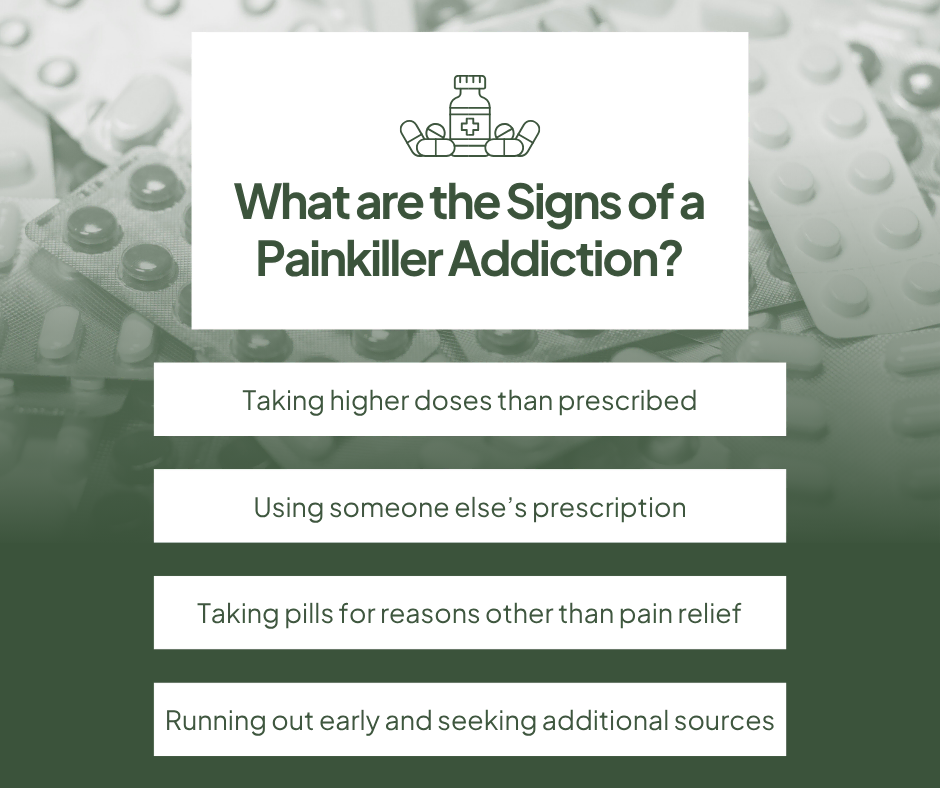If you are struggling with chronic pain, have just had surgery, or are dealing with an acute problem, you might be prescribed painkillers. Painkillers are one of the most effective ways to deal with significant pain from surgery or chronic pain conditions, and yet they have a high risk of addiction.
If they are not taken the right way or taken for too long, they can lead to dependence and addiction. Understanding the most common signs of a painkiller addiction can ensure that you learn to recognize them in yourself and others and get the help you need before it is too late.
Common Painkillers
Painkillers refer to prescription pain medication often prescribed by a doctor after a single event like a car accident or as a way to manage a chronic pain condition. Some examples include:
- Hydrocodone (Vicodin®)
- Oxycodone (OxyContin®, Percocet®)
- Oxymorphone (Opana®)
- Morphine (Kadian®, Avinza®)
- Codeine
- Fentanyl
Most people are unaware that the majority of common painkillers are medical versions of opioids, much the same as heroin, which is a derivative of an opioid. That means there is a high risk of addiction the longer you use prescription medications and several potential side effects.
- Prescription opioids are relatively easy to get, whether directly from your doctor, through doctor shopping where you use multiple doctors and report the same symptoms, or from people in your community
- Data trends of heroin addiction in the 2000s show that nearly 80 percent of people who use heroin reported using prescription opioids before using heroin
- 55 percent of teenagers who have misused an opioid say that they got it from family or friends
Because of the high risk of addiction, many people who are prescribed painkillers end up struggling with dependence and addiction long before they realize there is a problem. So what are the signs of a painkillers addiction?

Signs of a Painkiller Addiction
The signs of a painkillers addiction are not as obvious as you might think. While an obvious sign of addiction is taking the medication outside of the way it should be taken, like crushing a pill and injecting it, more often than not, it starts as simple things.
Some common examples include:
- Taking your medication in a dose beyond what is prescribed
- Taking medication from someone else’s prescription
- Taking medication for a reason other than what was prescribed
Consider this:
John receives a prescription for Percocet after an injury at work. He damaged his spine and had surgery. Now he is in recovery. He is supposed to take one pill every eight hours.
After several weeks of taking his medication regularly, he realizes the effects of one pill do not last eight hours. They only last six.
So, back at work and in great pain, John starts taking his medication every six hours instead of every eight.
Then, he runs out of pills a few days before he can get a refill. So John, now irritable and struggling with withdrawal, finds a friend who is on medication, visits them, and steals some of their pills from the bathroom when they aren’t looking.
Most people struggle with signs of a painkillers addiction in the exact same way as John: they were given a prescription for a legitimate need, but soon they developed a tolerance, so the medication stopped working as well. So, they changed how much or how frequently they took it, worsening the dependence and addiction. When they ran out, they turned to other sources for more.
Treating Painkiller Addiction with Sequoia Recovery Centers
If you are struggling with an addiction to painkillers, Sequoia Recovery Centers can help. Our prescription drug detox program can accommodate any schedule. Our drug and alcohol detox center offers a full continuum of care, including detox, inpatient care, PHP, IOP, and outpatient programs. No matter where you are in your recovery journey, we can help.
Contact Sequoia Recovery Centers for more information on signs of a painkiller addiction to look for and how our substance abuse treatment programs can help.

